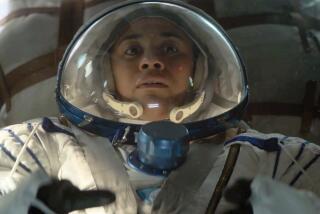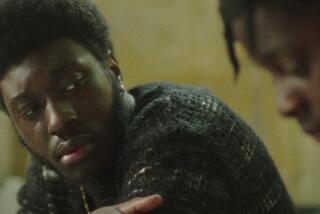Future has style, not sizzle in ‘Code 46’
When you attempt a romance set in the future, as director Michael Winterbottom and screenwriter Frank Cottrell Boyce have done in “Code 46,” the degree of difficulty is doubled. Your film has to convincingly evoke the future as well as make an emotional connection. “Code 46” can do one but has increasing trouble with the other.
The best thing about “Code 46,” photographed by Alwin Kuchler and Marcel Zyskind, is the artful way it uses real locations to create a believable near-future without resorting to ruinously expensive special effects.
Shooting in Shanghai, Dubai and India, the “Code 46” team has come up with a stylized world that seems familiar yet unusual and different, a crowded, barren universe that Winterbottom admits drew on his experience making his last film, the gritty refugee drama “In This World.”
Writer Boyce, who’s collaborated with the director on several films, including “24 Hour Party People” and “Welcome to Sarajevo,” has come up with several intriguing concepts for the rules under which this future functions.
It’s a place where cities are fortresses that make entry difficult, where daylight is dangerous so people work at night, where small pieces of paper called “cover” are needed to travel between cities and the all-powerful Sphinx (“The Sphinx knows best”) determines who gets to go. Most intriguing of all, it’s a world where you can be given viruses to teach you anything from singing to Chinese.
It is also a society where increased cloning has made it difficult for people to know who is related to whom. Code 46, the legal document that gives the film its name, lays out the stringent penalties for people who enter into relationships with someone to whom they are genetically linked.
It’s the future’s version of the love that dares not speak its name.
Enter protagonists William (Tim Robbins) and Maria (Samantha Morton). He is an investigator, armed with an empathy virus that enables him to read minds, and he’s been sent to Shanghai to ferret out a person who’s been forging cover.
Maria turns out to be a prime suspect, but William couldn’t care less because, despite a wife and child back home in Seattle, he’s fallen heedlessly in love with her. Even in the future, some things remain the same.
On paper this sounds perfectly acceptable, but the difficulty is that Winterbottom, who’s never been a director with a gift for warmth, can’t make this romance come alive. Morton and Robbins are gifted actors, but they seem straitjacketed here, and the film finds it difficult to avoid tedium as their lugubrious relationship unfolds.
Not helping things is “Code 46’s” decision to have its characters speak a futuristic slang whose polyglot mixture of languages (boys and girls, for instance, are chicos and chicas) only adds to the tedium. Our eyes can be convinced that something is really the future, but our ears are harder to fool.
*
‘Code 46’
MPAA rating: R for a scene of sexuality, including brief graphic nudity
Times guidelines: Adult subject matter, scenes of lovemaking, including nudity
Tim Robbins...William
Samantha Morton...Maria
Om Puri...Backland
Jeanne Balibar...Sylvie
United Artists presents, in association with the UK Film Council’s Premiere Fund and BBC Films, a Revolution Films production, released by United Artists. Director Michael Winterbottom. Producer Andrew Eaton. Executive producers Robert Jones, David M. Thompson. Screenplay Frank Cottrell Boyce. Cinematographers Alwin Kuchler, Marcel Zyskind. Editor Peter Christelis. Costumes Natalie Ward. Music The Free Association. Production design Mark Tildesley. Supervising art director Mark Digby. Set decorator Michelle Day. Running time: 1 hour, 30 minutes.
Exclusively at the AMC Century City, 10250 Santa Monica Blvd., Century City, (310) 289-4AMC; and ArcLight Cinemas, 6360 Sunset Blvd., Hollywood (323) 464-4226.
More to Read
Only good movies
Get the Indie Focus newsletter, Mark Olsen's weekly guide to the world of cinema.
You may occasionally receive promotional content from the Los Angeles Times.











